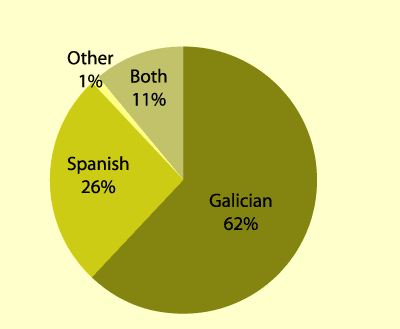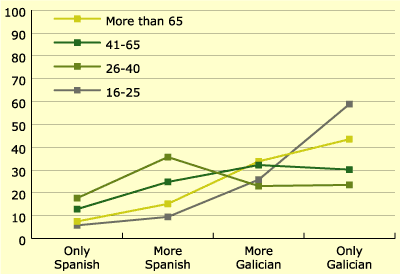
| Sociolingüística internacional |
| Winter 2002 |
The draft of measures to improve attitudes towards the Galician language and the extension of its use, by the Research team of the Seminar of Sociolinguistics of the Real Academia Galega |
||||
The Seminar of
Sociolinguistics of the Real Academia Galega [Galician Academy of Language] (1) gives in this article an overview
of the most relevant research projects carried out since its foundation and which have
been funded by public institutions. We focuse on the project we are currently developing
and which gaves name to this article. In the nineties, the Real Academia Galega elaborated
the Sociolinguistic Map of Galicia (MSG), a wide-range quantitative study, made up of more
than 38,000 interviews, where detailed information was given about fourth dimensions of
the sociolinguistic situation: initial language, competence, uses and linguistic
attitudes.
|
|||
| Summary1.
Introduction 1.1 The Sociolinguistic Map of Galicia 1.2 Developing Policies to improve the Conversion of Language Competence in Language Use among Young Adults Groups 1.3 The draft of measures to improve attitudes towards the Galician language and the extension of its use 2. Tools
and methodology 1. Introduction 1.1 The Sociolinguistic Map of Galicia (MSG) The Seminar of Sociolinguistics of the Real Academia Galega has been carrying out several researches about the sociolinguistic situation of Galicia, in cooperation with public institutions since its foundation in 1990. In addition to the project reviewed in this article, the Seminar of Sociolinguistics of the RAG, together with the Directorate General for Language Policy of the Xunta de Galicia [Directorate General for Language Policy of the Government of Galicia], carried out the Sociolinguistic Map of Galicia in order to know about the Galician linguistic situation insofar as there was a lack of reliable data regarding the current vitality and reality of the Galician language. The preparation of this study started in 1992 and ended in 1996 with the publication of the last of the three volumes of the MSG. 38,897 interviews (PDF 36 k) were carried out among the population aged 16 and over living in Galicia. 36 sectors were established according to the size of the municipality and the percentage of people employed in the different economic activities. Within every sector, the sample was proportionally distributed between the municipalities, and quotas were established according to age group and gender. The questionnaire was made up of 148 questions, some of them with subdivisions, so that the total number of variables gathered was of 170. The issues contained in the questionnaire were as follows: a) Personal identification data of the interviewee: name, place of birth and residence, gender, age, occupation, studies, etc. b) Linguistic competence: knowledge of Galician of the interviewee and his/her family. c) (Socio-)linguistic history of the interviewee: initial language, language used at school, language used by close relatives, etc. d) Linguistic uses of the interviewees in different domains: family circle, with friends, at work, with the Administration, etc. e) Linguistic attitudes and prejudices with regard to Galician in different domains: towards the use of Galician in different situations, the usefulness of Galician compared to Spanish, the increase of use of Galician, the Galician speakers, the Spanish speakers, etc. f) Sociolinguistic awareness of the interviewee: usual language of youngsters, the future of languages in Galicia, level of use of Galician in different moments of the last 50 years, etc. g) Check questions (interviewer) The Sociolinguistic Map of Galicia was published by the Real Academia Galega in three volumes (Seminario de Sociolingüística, 1994, 1995, 1996) which contain a synthesis of the most relevant data by using three basic parameters: the competence in Galician, its uses and the attitudes towards this language. One of the most relevant results stated in volume one of the MSG was the break-up of the intergenerational transmission of Galician as far as even if the majority of the population (62.4%) claimed Galician as initial language, this percentage varies substantially according to the age group. The difference between initial Galician speakers and initial Spanish speakers from the group of elders (over 65) to the group of youngsters (between 16 and 25 y.o.) is more than 70%. Furthermore, among people under 20 y.o., Spanish is in most cases the initial languag, no matter characteristics as relevant as the place of residence at birth. Figure
1: Initial language in Galicia As for linguistic competences, the MSG shows a predominance of oral competences in Galician, as almost all interviewees claimed to understand Galician (97.1%) and a vast majority claimed to be able to speak it (86.4%). Noneless, the written skills are more limited as less than half the population can read in Galician (45.9%) and slightly over a quarter can write it (27.1%). Regarding linguistic uses, the MSG states that the majority language in Galicia is Galician: almost 70% of interviewees claim to speak only (38.7%) or mostly (29.9%) this language. Nevertheless, the use of Galician changes according to variables such as place of residence, age, level of studies or social class. Broadly speaking, the MSG proves a general decrease of Galician from rural areas to towns and from towns to cities. The use of Galician also decreases according to the age and in those groups with a higher level of instruction and a higher socio-economic status. If we focuse on the relation between usual language and age, the MSG shows a worrying process of language shift. In the whole Galicia, Spanish is now the dominant language among youngsters (53.4% of those interviewees aged between 16 and 25 speaks only or mostly in Spanish). Figure 2. Usual language in Galicia
At the same time a general report was submitted to the Xunta de Galícia [autonomous Government of Galicia] with the analysis of all data and a level of concretion far more higher than the results published in the 3 volumes that, even if detailed, are merely a synthesis of the data collected in the map. 1.2 Developing Policies to improve the Conversion of Language Competence in Language Use among Young Adults Groups The Seminar of Sociolinguistics of the Real Academia Galega carried out the Galician part of the project Developing Policies to improve the Conversion of Language Competence in Language Use among young Adult Groups. The objective of the study was to develop systems to improve the step between competence and use in groups of young people. The work was coordinated by Pádraig Ó Riagáin of the Linguistics Institute of Ireland and the other participants were the Seminar of Sociolinguistics of Galicia, the Directorates General for Language Policy of Catalonia and Basque Country, the Research Centre Wales, and the afore-mentioned Linguistics Institute of Ireland. The part refering to Galicia is a macro-quantitative study about the congruence or non-congruence between oral competence and use of the Galician language among a sub-sample of people aged between 16 and 34, which was the source for a subsequent study about the influence of social networks over this congruence. On the other hand, the influence of the changes ocurring in the social networks of daily interaction over the linguistic behaviour of speakers was also studied. The results of this research in Galicia were published in two articles: Fernández Rodríguez, M. & Rodríguez Neira, M. (1998a) and Fernández Rodríguez, M. i Rodríguez Neira, M. (1998b). 1.3 Deseño de medidas para mellorar las actitudes cara ó galego e incrementa-lo seu uso The Seminar of Sociolinguistics of the Real Academia is carrying out the project The draft of measures to improve attitudes towards the Galician language and the extension of its use which is being funded by the Directorate General for Language Policy of the Galician Government [Xunta de Galicia]. This project began in March 1999 and is now almost completed. The results will be published as a monograph in the near future. |

